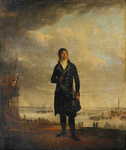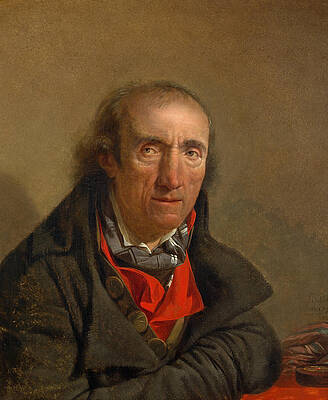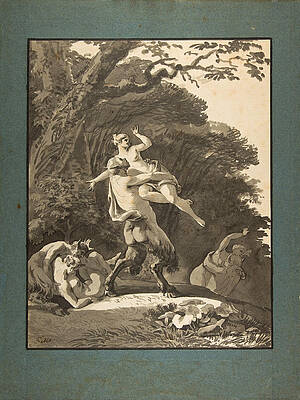Jean-François Sablet
Portrait of a Revolutionary

Portrait of Louis Crucy in a Shipyard






Portrait of Eugene Crucy 9 years old

Fernande Crucy, aged two, and Marguerite Balley







Marguerite Colette Le Roux, wife of Antoine Michel Crucy

Mathurin-Michel Peccot architect






Satyrs Abducting Nymphs
Jean-François Sablet (23 November 1745, Morges - 24 February 1819, Nantes) was a French painter; part of a family of artists of Swiss origin.
Biography
Jean-François Sablet was the older brother of Jacques-Henri Sablet (1749-1803). They were sons of the painter and picture dealer Jacob Sablet (1720-1798). They both studied at the Académie royale de peinture et de sculpture in Paris as pupils of Joseph-Marie Vien. Jean-François studied at the Académie in 1768-1773 and Jacques-Henri in 1772-1775. Although their careers did not follow a similar course, the attribution of their works has frequently been confused.[1]
He was the son of a decorator and gilder from Lausanne, he studied with his father before moving to Paris in 1772. In Paris he worked with Joseph-Marie Vien for three years. When in 1775 Vien was named director of the French Academy in Rome, Sablet accompanied him there. His ambition was to be a history painter, but facing competition from Jacques-Louis David and Pierre Peyron, among others, and lacking solid academic training, he could win no commissions. Instead he turned to portraiture, genre painting, and landscape painting. Most of his genre scenes depicted the city's everyday life and customs of the Campagna.[2]
Portrait of a Conventionnaire
Among Jean-François Sablet's early portraits are those of Charles de Bourbon, Comte d'Artois, as Colonel General of the Swiss and Grison Guards (1774; ex-Bourbon-Chalus Collection, Paris) and Charles-Henri, Comte d'Estaing (untraced). He also painted genre scenes, such as Childhood in the Country and Visit to the Wet-nurse (both untraced), and mythological scenes (e.g. Nationalmuseum, Stockholm).[3]
In 1791 Jean-François left Paris for Rome to join his brother Jacques-Henri. While there he concentrated on landscapes, also depicting people in local costume. In February 1793 Jean-François Sablet was obliged to leave Rome with the rest of the French community and by October was in Paris as a member of the Revolutionary Commune des Arts. He produced a number of Revolutionary portraits, including Joseph-Agricol Viala, William Tell and Lycurgus (all untraced), but spent most of his time quietly in Normandy. In 1802 he worked in Paris for the printmakers Francesco Piranesi (1758-1810) and his brother Pietro Piranesi (1773-after 1807), the sons of Giovanni Battista Piranesi. In 1805 he established himself in Nantes, producing small-scale portraits of the city's notables with sometimes scathing sincerity. In 1812 he decorated the Le Palais de la Bourse in Nantes, with six large grisailles depicting the Visit of Napoleon to Nantes in 1808 (untraced).[4]
References
Web Gallery of Art, Biography Jean-François Sablet (b. 1745, Morges, Vaud, d. 1819, Nantes).
Web Gallery of Art, Biography Jacques-Henri Sablet (b. 1749, Lausanne, d. 1803, Paris).
Web Art of Gallery, Biography Jean-François Sablets (b. 1745, Morges, Vaud, d. 1819, Nantes).
Web Art of Gallery, Biography Jean-François Sablets (b. 1745, Morges, Vaud, d. 1819, Nantes).
----
Fine Art Prints | Greeting Cards | Phone Cases | Lifestyle | Face Masks | Men's , Women' Apparel | Home Decor | jigsaw puzzles | Notebooks | Tapestries | ...
----
Artist
A - B - C - D - E - F - G - H - I - J - K - L - M -
N - O - P - Q - R - S - T - U - V - W - X - Y - Z
Retrieved from "http://en.wikipedia.org/"
All text is available under the terms of the GNU Free Documentation License




